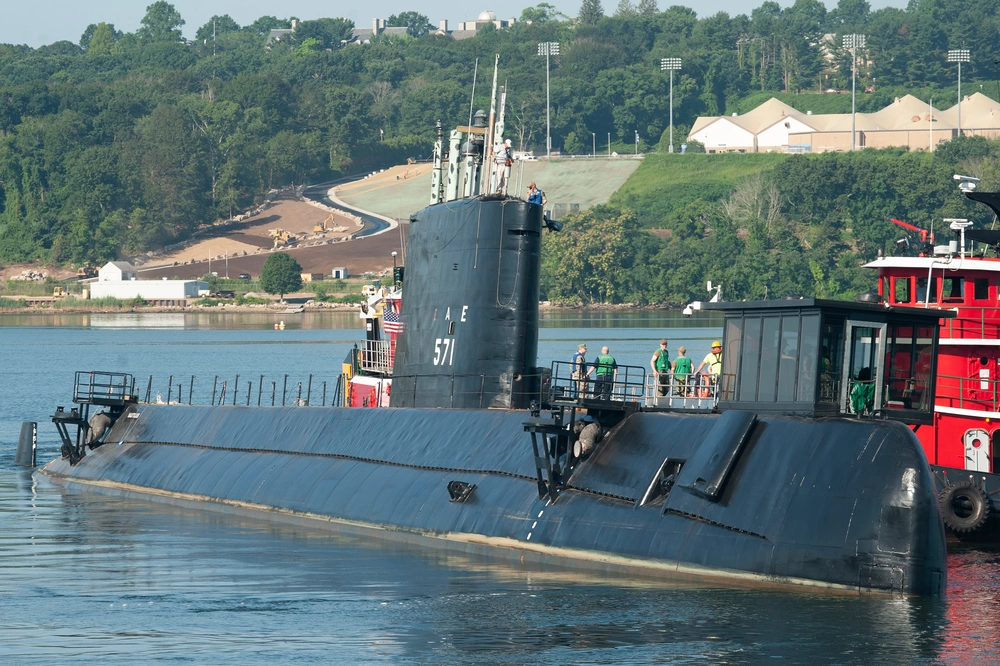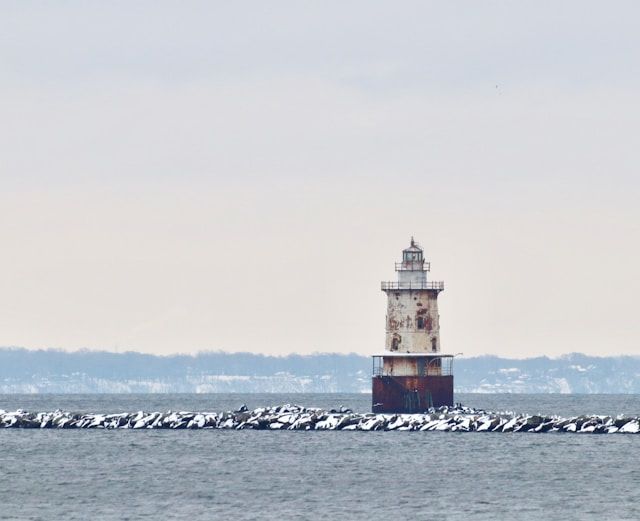
The USS Nautilus sits proudly at the Submarine Force Museum in Groton, Connecticut, offering visitors a rare glimpse into naval history. This historic vessel holds the distinction of being the world’s first nuclear-powered submarine and the first ship to travel to the North Pole underwater. Located along the Thames River, the Nautilus has been carefully preserved as a National Historic Landmark since 1982.
When you visit the USS Nautilus, you can enjoy a self-guided tour through the submarine’s interior spaces. You’ll walk through torpedo rooms, control towers, living quarters, and more while learning about life aboard this revolutionary vessel. The adjacent Submarine Force Museum enhances your experience with exhibits that tell the story of the U.S. Navy’s submarine program and the Nautilus’s groundbreaking achievements.
Find available hotels and vacation homes instantly. No fees, best rates guaranteed!
Check Availability Now
USS Nautilus
The USS Nautilus is a historic submarine with an impressive legacy. As the world’s first nuclear-powered submarine, it changed naval history forever when it was launched in 1954. The vessel operated until 1980, completing groundbreaking missions throughout its service.
You can explore this engineering marvel at the Submarine Force Museum in Groton. The museum offers free admission, making it an accessible attraction for visitors of all ages. When you step aboard the Nautilus, you’ll walk the same passageways as the brave sailors who served on this revolutionary vessel.
The submarine’s most famous achievement came in 1958 when it completed Operation Sunshine, becoming the first vessel to cross the North Pole beneath the ice. This historic journey captured worldwide attention and demonstrated the incredible capabilities of nuclear propulsion.
During your visit, you’ll see the cramped quarters where crew members lived, the command center where critical decisions were made, and learn about life underwater in this pioneering submarine. The self-guided tour provides fascinating insights into submarine technology and naval history.
Rating: 4.8 (1800 reviews)
Location: 1 Crystal Lake Rd, Groton, CT 06340
Contact: (860) 694-3174
Website: Visit Website
History of the USS Nautilus
The USS Nautilus revolutionized naval warfare as the world’s first nuclear-powered submarine. Its groundbreaking technology and historic voyages changed submarine operations forever and secured its place in maritime history.
Development and Construction
The USS Nautilus began as a vision by Admiral Hyman G. Rickover, who pushed for nuclear propulsion in submarines. In 1951, Congress approved funding for this revolutionary vessel. The submarine’s keel was laid down on June 14, 1952, at Electric Boat Division of General Dynamics in Groton, Connecticut.
First Lady Mamie Eisenhower christened the Nautilus on January 21, 1954. The submarine was commissioned later that year on September 30, with Commander Eugene P. Wilkinson in charge. Unlike traditional diesel-electric submarines, the Nautilus featured a nuclear reactor that allowed it to remain submerged for months without surfacing to recharge batteries.
This innovative design gave the Nautilus unprecedented underwater speed and endurance. At 323 feet long and displacing 3,180 tons, it was larger than previous submarines to accommodate its nuclear propulsion system.
Key Milestones
The Nautilus made history on January 17, 1955, when Commander Wilkinson sent the famous message: “Underway on nuclear power.” This marked the beginning of a new era in naval operations. In 1958, the submarine achieved perhaps its most famous accomplishment – Operation Sunshine, the first crossing of the North Pole beneath the ice cap.
During its 25-year career, the Nautilus traveled over 500,000 miles and served as a test platform for various technologies, including early submarine satellite communications. The vessel broke numerous records for speed and submerged endurance that were previously impossible with conventional submarines.
After decommissioning on March 3, 1980, the Nautilus was designated a National Historic Landmark in 1982. Following restoration work at Mare Island Naval Shipyard, it returned to Groton in 1985. Today, you can visit this historic submarine at the Submarine Force Library and Museum in Groton, Connecticut, where it welcomes around 250,000 visitors annually.
Life Aboard the USS Nautilus
The USS Nautilus offered unique living conditions for its crew as they made history beneath the waves. Crew members adapted to tight spaces and developed routines that helped them navigate both their duties and daily life.
Living Quarters
Space on the Nautilus was extremely limited. Sailors lived in cramped conditions where every inch mattered. The submarine featured “hot bunking,” where three sailors shared two bunks in rotating shifts.
Most enlisted men slept in narrow bunks stacked three high. These sleeping areas were scattered throughout the vessel, often near noisy equipment. Officers had slightly better accommodations, with small staterooms shared by two or three people.
The mess hall doubled as a recreation area where crew members could relax, watch movies, or play cards when off duty. Personal storage was minimal – just a small locker for each sailor’s belongings.
Despite the tight quarters, sailors created a sense of home through photos, small mementos, and the close bonds they formed with shipmates.
Daily Life for Crew Members
Life aboard Nautilus followed a structured 18-hour cycle with three 6-hour shifts. This meant you were either on duty, off duty, or sleeping at any given time. The nuclear power plant allowed for extended underwater missions that conventional submarines couldn’t match.
Meals were a highlight of the day. The galley crew worked magic in their tiny kitchen, preparing surprisingly good food that boosted morale. Fresh bread was baked daily, and ice cream was a special treat.
Personal hygiene was challenging. You had to take quick “submarine showers” to conserve water, wetting down, turning off the water to soap up, then rinsing quickly.
Entertainment options were limited. Crew members read books, wrote letters, played cards, or watched movies. The close quarters fostered strong friendships and a unique submarine culture where teamwork wasn’t just encouraged—it was essential for survival.
Educational Importance and Tours
The USS Nautilus offers visitors a remarkable educational experience through its thoughtfully designed programs and immersive tour options. The historic submarine serves as a floating classroom where maritime history comes to life.
Educational Programs and Exhibits
The Submarine Force Museum features interactive exhibits that explain nuclear propulsion in simple terms. You’ll find displays about the Cold War era and the Nautilus’s historic journey under the North Pole in 1958.
School groups receive special attention with tailored programs matching different grade levels. These programs align with educational standards and provide hands-on learning opportunities.
The museum’s archive contains thousands of historical documents and photographs. Researchers and history buffs can access these materials by appointment.
Special exhibits rotate throughout the year, keeping the experience fresh even for repeat visitors. Look for themed exhibits about submarine technology, famous missions, and life underwater.
Tour Experiences
When you board the USS Nautilus, you’ll walk the same passageways as the original crew members. The self-guided tour takes you through several compartments of this revolutionary vessel.
The control room stands as the highlight of the tour, showing where officers navigated this historic submarine. You can see actual equipment used during the Nautilus’s service years.
Crew quarters reveal the tight living conditions submariners endured. You’ll be amazed at how sailors managed daily life in such confined spaces.
Tour guides, often former submariners, are available to answer questions and share personal stories. Their firsthand knowledge adds depth to your visit that no guidebook can match.
Plan to spend about 45 minutes exploring the submarine itself. Wear comfortable shoes as the tour involves navigating through tight spaces and stepping through hatches.
Find available hotels and vacation homes instantly. No fees, best rates guaranteed!
Check Availability Now









